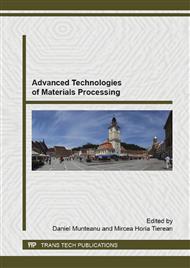p.26
p.35
p.44
p.51
p.58
p.64
p.72
p.80
p.88
Effects of Vibration and Salts Treatments on Aluminium Alloy Properties Used in Mould Manufacture
Abstract:
Metallic mould properties are influenced by the technological process used on casting. The mechanical properties of aluminium castings can be affected by dissolved gases, heterogeneous impurities or shrinkage remaining in casting after solidification. Dissolved gases and oxide inclusions in aluminium all have a deleterious effect on casting quality. The treatment of molten aluminium using vibrations and salts was found to be highly efficient in refining the microstructure of the alloy. The main objective of the paper is to understand the effects of vibrations and salts treatment on the final microstructure and changes that take place and influences aluminium alloy properties used in mould manufacture. The microstructural changes have a great significance in improving the properties of aluminium alloy castings. Understanding this effects and the modification mechanism can undoubtedly be of great significance for improving casting quality. Fluxes based on a KCl-NaCl mixture may be used to cover and protect the metal from oxidation. Most fluxes are based on a mixture of KCl and NaCl, which forms at low-temperature (665 °C) eutectic.
Info:
Periodical:
Pages:
58-63
Citation:
Online since:
October 2015
Authors:
Keywords:
Price:
Сopyright:
© 2015 Trans Tech Publications Ltd. All Rights Reserved
Share:
Citation:


